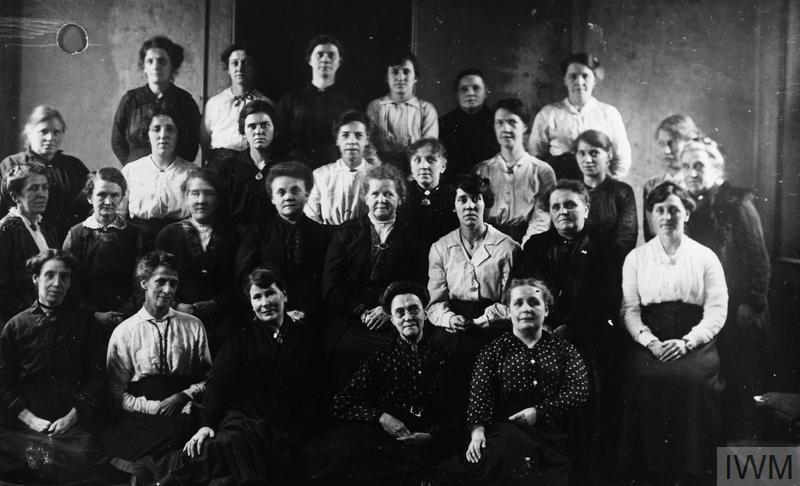
Women of the Girlington Club, Bradford, set up in the First World War for charitable and patriotic purposes ©IWM (Q108592) www.iwm.org.uk/collections/item/object/205351371
Contributed by Julie Moore
As promised, the pieces which appear under the title of ‘Anonymous Women’ will be a ‘warts and all’ account of my research process. Already, just a few days in, it is becoming clear that there is a real problem around that title which seemed such a catchy one when I first thought of it.
In conversation with colleagues around the very early thoughts forming on this subject, it occurred to us that we were guilty of a fair bit of historical arrogance – by we, I should make it plain, I mean me. For, of course, simply because we do not know their names today, a century on, does not mean they were anonymous in their own times and communities. The image at the head of this page is of the members of the Girlington Club, set up in Bradford for charitable and patriotic purposes. I know this because the site on which the photo appears www.iwm.org.uk tells me so. What I do not know are the names, backgrounds, and personalities of the ladies themselves, but within their own communities they would have been well-known; which one of them was a dab hand at making cakes, who could always be relied upon to turn up and lend a hand with the tea urn, who was the biggest gossip, and who was the bossy one who organised them all.
These women were not anonymous at all, but they have disappeared from so many of the stories around the First World War. They are not glamourous, wear no uniforms and, unless we are very lucky, have left behind no minute books telling of lengthy or stormy committee meetings, plans for fundraising, or accounts of charities supported. Not anonymous to themselves or their communities, they are in danger of becoming anonymous within the story of the war which was the background to all their lives.
It is so much easier for those of us researching community stories to focus on the named ones, be it on war memorials or in minute books and newspapers. These sources offer us rich pickings for finding local stories, but so often the women who appear in photos such as the one above do not surface in these accounts. We may not be able to put names to faces, but what I hope this research project will do is bring them out of the shadows and throw light on their contribution in a way that adds greater substance to the story of everyday life during the war.
It is early days yet and I am still optimistic that, despite the difficulties, we can uncover at least some of the range of experiences of what might be called ordinary women; although, as a phrase, that comes close to patronising a group of people whose lives were as complex, difficult and fulfilled as any other.
Do send me examples of your own ‘anonymous women’ or your suggestions for a more accurate title for this research. Perhaps ‘disappearing women’ might work as an alternative. I am open to suggestions and if, by a great good stroke of luck, you know anything about the Girlington Women, then do get in touch and we can start to recover their contribution.
I leave you with a final image, also to be found on the IWM website, of the ladies dressed up for an amateur dramatic performance – wouldn’t you just love to see them the moment after the photographer had finished and they relaxed. The lady dressed as a policeman looks as if she would be quite a giggler if given the chance.

Women of the Girlington Club, Bradford, set up in the First World War for charitable and patriotic purposes ©IWM (Q108592) www.iwm.org.uk/collections/item/object/205351064




